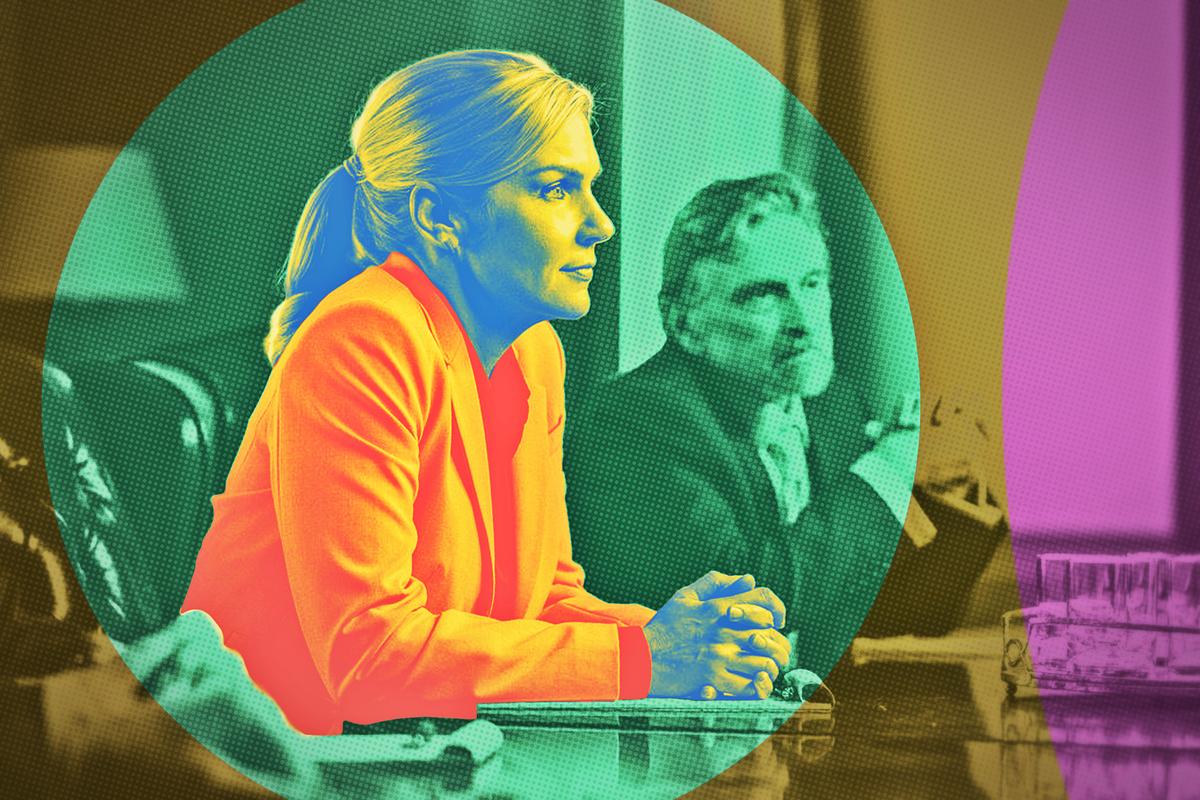
“You know, I’m worried about Kim” is, I would guess, the single most common sentiment on the minds of anxious Better Call Saul viewers. But that concern—and the uncertainty that comes from not knowing a beloved character’s fate—is what you sign up for when getting invested in a show. We can assume Kim Wexler is doomed, and we can worry about it all we want, but her fate is out of our hands. That’s why it’s particularly alarming when those words are coming from the guy responsible for creating the show. At the midway point of Better Call Saul’s fifth season, in a YouTube featurette, cocreator Peter Gould says what we’re all feeling: Kim is heading down a slippery slope. The more she helps Jimmy McGill prevent her own client, Mesa Verde Bank and Trust, from evicting an old man from his home to build a call center in Tucumcari, New Mexico, the more she’s putting herself at risk.
If there was ever a sign that Better Call Saul is clearly content doing its own thing instead of trying to emulate Breaking Bad, it would come from the fact that one of the central conflicts of the penultimate season is, incredibly, about the ethics of legally evicting someone. (Honestly, the series deserves even more plaudits than its predecessor just for making all this legalese compelling to watch.) It’s that tension between morality and legality, and the realization that the two aren’t mutually exclusive, that’s playing out within Kim—she’s caught between doing her job, trying to do the right thing, and the thrill that comes from trying to do both.
You can understand why she’s attracted to Jimmy, who’s driven by similar impulses, and why collaborating on an elaborate con is a firecracker for their relationship. But while Kim is able to check herself before leaning to one extreme, Jimmy’s id—especially now that he’s fully embraced his alter ego, Saul Goodman—is becoming increasingly harder to contain. The persistent anxiety for Better Call Saul fans is that Jimmy-as-Saul will take things too far, and Kim will be caught in the cross fire. It’s been discussed ad nauseum, but is still worth repeating: There’s a reason we never see or hear about Kim in Breaking Bad, and it’s probably not good.
But what makes the sixth episode of the penultimate season, “Wexler v. Goodman,” so terrific is how their relationship constantly evolves and subverts expectations—it’s all the more tragic because Kim has every reason to leave Jimmy, but she still can’t bring herself to do it. If there had to be a single moment used to illustrate the singularity of Kim, and the phenomenal performance being delivered by Rhea Seehorn, it would be the scene at the end of the episode when, in the same breath as she tells Jimmy they ought to break things off before he hurts her again, she posits they should get married. (Quite a mic drop before the credits hit!)
Jimmy and Kim’s relationship spiraled out of control when Kim changed her mind about escalating the dispute between Mesa Verde and Mr. Acker. After uncovering old footage of Mesa Verde chief executive Kevin Wachtell’s father, the bank’s founder, doing commercials—along with crucial information pertaining to the company’s logo, a cowboy on a horse next to a cactus—Jimmy believes he has enough ammunition to keep Mr. Acker from having to leave his home. But Kim tells Jimmy that Mesa Verde would be willing to pay the old man an additional $70,000 on top of the standard payout to leave the premises—and if the company isn’t willing to pay that much, she’ll cover the rest out of her own pocket. Kim is certainly doing this to clear her conscience and escape her own legal troubles—she could be accused of malfeasance if anyone found out she was conspiring with Jimmy against her own client—but it’s still a good gesture that would give Mr. Acker more than enough to move on with his life.
Jimmy is clearly dismayed about having to put an epic scheme on the shelf after doing most of the work, and you get the impression that the only person in the world he’d be willing to buck those temptations for is Kim. The dynamic between Jimmy and Kim reminds me a lot of that between Chuck and Wendy Rhoades on the Showtime series Billions. Rather than be scandalized by Chuck’s absurd behavior, Wendy often endorses his misdeeds, and is sometimes an accomplice. But Wendy still drew a line in the sand in the fourth season, asking Chuck not to go public about their BDSM-heavy sex life. (Billions is incredible, and thanks to the ongoing COVID-19 pandemic, it might be the only good show airing in May.) When Chuck betrays Wendy and tells the world his wifey consensually spanks his butt, it creates a potentially irreparable fissure in their relationship. A relationship, even one as conniving as Chuck and Wendy’s, is predicated on trust.
Jimmy’s own betrayal of Kim in this episode seems, like much of his worst behavior, entirely impulsive. While buzzing off the adrenaline of embarrassing Howard Hamlin in front of peers by paying two hookers to pretend Hamlin owes them money, Jimmy decides he will screw over Mesa Verde without Kim’s consent. The stage is set for an excruciating showdown, in which Kim believes Jimmy is meeting with her and the rest of the Mesa Verde team to arrange Mr. Acker’s financial settlement. Instead, at the meeting, Jimmy lays out all the ways he will make Kevin’s life a living hell: Using the old commercial footage and a green screen, Jimmy gets paid actors to make erroneous claims about Mesa Verde—how the bank was responsible for home evictions, has black mold in their offices, uses hidden fees to “fund terrorism,” and so on. He is also planning to file an injunction against the company’s logo, because the photographer who originally snapped that cowboy image—a Native American woman, now in her 90s—wasn’t properly compensated. Even if the injunction fails, Mesa Verde would have to remove all their logos until the matter is settled in court; combined with the attack ads, the bank’s reputation would be severely damaged. To avoid a PR nightmare, Kevin agrees to move the call center from Mr. Acker’s property, pay the photographer $200,000, and issue public apologies to both of them.
Bob Odenkirk is still as smarmy as he’s ever been, but the real standout performance in “Wexler v. Goodman” comes from Seehorn. She makes you feel every bit of Kim’s anger and anguish at being on the receiving end of Jimmy’s con instead of a co-conspirator. “That anger—real anger—it worked like a protective immunity shield,” Jimmy tries assuring Kim later in her apartment, knowing she couldn’t be implicated in something she didn’t see coming. “Emotion like that, you can’t fake it!” That’s exactly the problem. “I don’t trust you,” Kim says. “I can’t do this anymore.”
Kim’s tolerance for Jimmy’s shady antics has waned for a while. You could argue the point of no return was (or at least should’ve been) in the Season 4 finale, when Kim falls for Jimmy’s crocodile tears in court about his brother’s death so he could be reinstated as a lawyer. But even then, the scheme wasn’t intended to manipulate her emotions; it was for the panel deciding his fate. If, as I’d previously described, Better Call Saul feels like a death by a thousand cuts, then Jimmy’s behavior this week seems like a fatal puncture.
But Kim is nothing if not unpredictable. She’s conflicted between breaking things off for good and marrying the man who can’t even look her in the eyes and say he won’t lie to her again. If we compare the show to Breaking Bad, it’s like Kim can’t let go of an addiction: She loves Jimmy, but just as much loves the rush of what he represents. Seehorn is putting in an Emmy-worthy performance that resists easy labels. In the past two seasons, Seehorn has relished the chance to let the previously restrained Kim release some of her pent-up frustrations. She began with her excoriation of Howard last season, which was as much about reckoning with her own guilt and moral compromises as everything Jimmy’s done. In lesser hands, her moral descent might feel hackneyed, but Seehorn lets the character’s foibles, contradictions, and insecurities speak for themselves.
We know Saul Goodman’s own reckoning won’t arrive until after the Breaking Bad timeline—when he’s “Gene Takovic,” a mustachioed Cinnabon employee in Omaha, Nebraska. Kim’s absence at that point would imply she already flew too close to the sun, and we can’t do anything to stop it—the same way nothing can stop Saul from having to change his identity (again), or Mike Ehrmantraut’s unceremonious death at the hands of Walter White. We tend to categorize Better Call Saul as a tragedy of inevitability for the characters whose fates were sealed in Breaking Bad (and beyond). But more than anything else in this brilliant and utterly devastating series, Kim Wexler is breaking our collective hearts—one costly yet uncertain misstep at a time.

